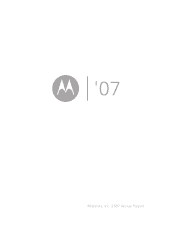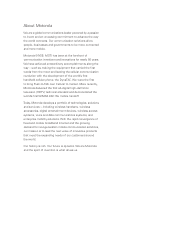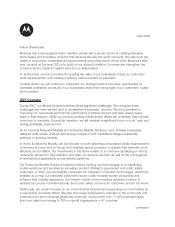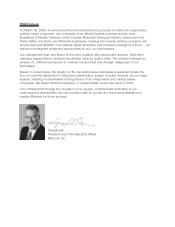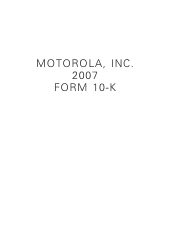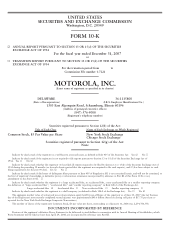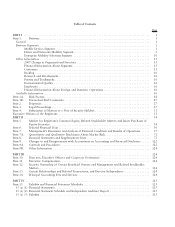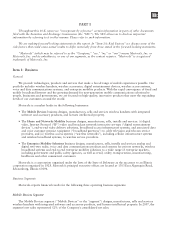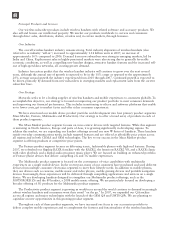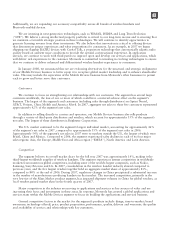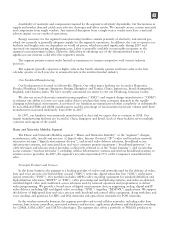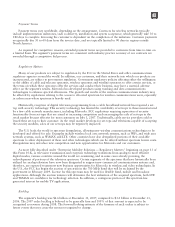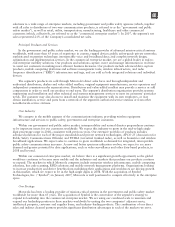Motorola 2007 Annual Report Download - page 11
Download and view the complete annual report
Please find page 11 of the 2007 Motorola annual report below. You can navigate through the pages in the report by either clicking on the pages listed below, or by using the keyword search tool below to find specific information within the annual report.
Additionally, we are expanding our accessory compatibility across all brands of wireless handsets and
Bluetooth-enabled devices.
We are investing in next-generation technologies, such as WiMAX, HSDPA and Long Term Evolution
(“LTE”). We believe a strong intellectual property portfolio is critical to our long-term success and to ensuring that
we maintain a favorable strategic position in these technologies. We will continue to identify opportunities to
generate licensing revenue from these investments. We also believe that innovation is critical to offering devices
that demonstrate unique experiences and value propositions for consumers. As an example, in 2007 we began
shipping our flagship RAZR2 devices with Crystal Talk, a proprietary technology that automatically adjusts audio
quality based on ambient noise conditions to provide the optimal conversational experience. In application
services, we continue to work with third parties to improve upon and develop our services and applications, which
will deliver rich experiences to the customer. Motorola is committed to investing in evolving technologies to ensure
that we continue to deliver enhanced and differentiated wireless handset experiences to consumers.
In January 2008, we announced that we are evaluating alternatives for the structural and strategic realignment
of our Mobile Devices business to better equip it to recapture global market leadership and to enhance shareholder
value. This may include the separation of the Mobile Devices business from Motorola’s other businesses to permit
each to grow and better serve their customers.
Customers
We continue to focus on strengthening our relationships with our customers. The segment has several large
customers worldwide, the loss of one or more of which could have a material adverse effect on the segment’s
business. The largest of the segment’s end customers (including sales through distributors) are Sprint Nextel,
AT&T, Verizon, China Mobile and America Movil. In 2007, aggregate net sales to these five customers represented
approximately 42% of the segment’s net sales.
In addition to selling directly to carriers and operators, our Mobile Devices business also sells products
through a variety of third-party distributors and retailers, which account for approximately 33% of the segment’s
net sales. The largest of these distributors is Brightstar Corporation.
The U.S. market continued to be the segment’s largest individual market, accounting for approximately 46%
of the segment’s net sales in 2007, compared to approximately 35% of the segment’s net sales in 2006.
Approximately 54% of the segment’s net sales in 2007 were to markets outside the U.S., the largest of which were
Brazil, China and Mexico. Compared to 2006, the segment experienced sales declines in each of its four major
sales regions: Asia, the Europe, Middle East and Africa region (“EMEA”), North America and Latin America.
Competition
The segment believes its overall market share for the full year 2007 was approximately 14%, making it the
third-largest worldwide supplier of wireless handsets. The segment experiences intense competition in worldwide
markets from numerous global competitors, including some of the world’s largest companies, such as Nokia,
Samsung, Sony-Ericsson and LG. In 2007, consolidation in the wireless handset industry slowed compared to
previous years, and the five largest vendors together held an aggregate market share of approximately 83%,
compared to 84% at the end of 2006. During 2007, regulatory changes in China precipitated a substantial increase
in the number of manufacturers producing handsets in that market. The increased competition, primarily in the
very low tier of the Mass Market product segment, has impacted shipment volumes in China for global vendors, as
local vendors gained market share in the fourth quarter of 2007.
Major competitors in the industry are moving to applications and services as key sources of value and are
increasing their focus and investments in these areas. In response, Motorola has created a global applications and
services team within the Mobile Devices segment to focus on building the applications and services business.
General competitive factors in the market for the segment’s products include: design; time-to-market; brand
awareness; technology offered; price; product proposition, performance, quality, delivery and warranty; the quality
and availability of service; and relationships with key customers.
3

